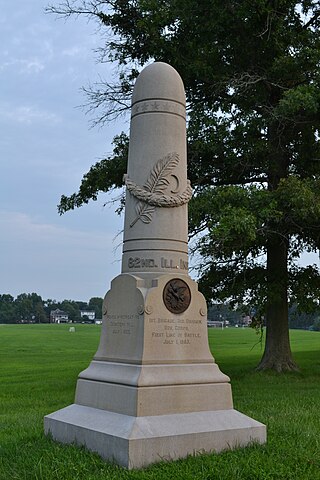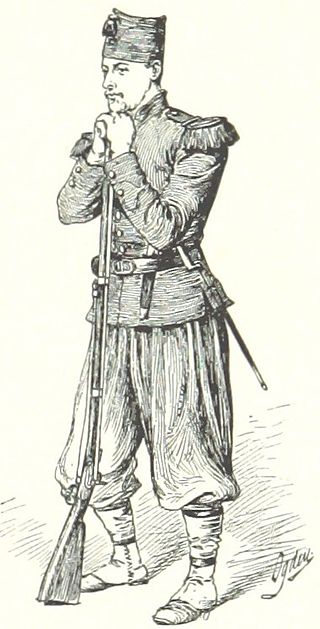
The 23rd Pennsylvania Volunteer Infantry was an infantry regiment that fought in the Union Army during the American Civil War. Known for its colorful uniforms based upon the popular French Zouave style, the regiment served in the Eastern Theater.

Alexander Schimmelfennig was a Prussian soldier and political revolutionary. After the German revolutions of 1848–1849, he immigrated to the United States, where he served as a Union Army general in the American Civil War.
The 106th Pennsylvania was a volunteer infantry regiment which served in the Union Army during the American Civil War. It was part of the famous Philadelphia Brigade, which helped defend against Pickett's Charge in the Battle of Gettysburg.
The 116th Pennsylvania Infantry was a volunteer infantry regiment in the Union Army during the American Civil War. It formed a part of the Irish Brigade.
The 6th New Jersey Infantry Regiment was regiment of infantry from New Jersey that served in the Army of the Potomac during the American Civil War.

The 118th Pennsylvania Regiment was a volunteer infantry regiment in the Union Army during the American Civil War. They participated in several major conflicts during the war including the Battle of Gettysburg, Siege of Petersburg, and escorted the truce flag of Robert E. Lee at the Battle of Five Forks. The regiment was led by Colonel Charles Prevost until he was seriously injured at the Battle of Shepherdstown in which Lieutenant-Colonel James Gwyn assumed command until the end of the war.
The 142nd Pennsylvania Volunteer Infantry was a volunteer infantry regiment that fought in the Union Army during the American Civil War. The regiment primarily served in the Army of the Potomac in the Eastern Theater and was heavily engaged in the first day of fighting at Gettysburg.

The 82nd Regiment Illinois Volunteer Infantry, known as the "2nd Hecker Regiment," was an infantry regiment that served in the Union Army during the American Civil War. It was one of the three "German" regiments furnished to the Union by Illinois. Approximately two-thirds of its members were German immigrants and most of the other third was composed of immigrants from various countries. Company C was almost entirely Jewish, and Company I all Scandinavians.
The 75th Ohio Infantry Regiment, sometimes 75th Ohio Volunteer Infantry was an infantry regiment from southwestern Ohio in the Union Army during the American Civil War. It served in the Eastern Theater, most notably in the battles of Chancellorsville and Gettysburg and then in the siege operations against Charleston, South Carolina.

The 140th New York Infantry Regiment was a volunteer infantry regiment that was created on September 13, 1862, for the Union Army during the American Civil War. From January 1864 they wore a Zouave uniform.

The 82nd Ohio Infantry Regiment, sometimes 82nd Ohio Volunteer Infantry was an infantry regiment in the Union Army during the American Civil War.

The 2nd Regiment Massachusetts Volunteer Infantry was an infantry regiment in the Union Army during the American Civil War. Major George H. Gordon, a West Point graduate and veteran of the Mexican–American War, organized the unit's recruitment and formation. The 2nd Massachusetts was trained at Camp Andrew in West Roxbury, Massachusetts on the site of the former Transcendentalist utopian community, Brook Farm. Roughly half the regiment was mustered in on May 18, 1861 and the remainder on May 25, 1861 for a term of three years. The regiment saw extensive combat as part of the Army of the Potomac particularly during the Battle of Antietam and the Battle of Gettysburg.

The 83rd Pennsylvania was a volunteer infantry regiment in the Union Army during the American Civil War, which participated in almost every major battle in the East, including Seven Days Battles, Antietam, Fredericksburg, Gettysburg, Petersburg and Appomattox Court House.

The 80th New York Infantry Regiment, originally designated the 20th New York State Militia Regiment, "Ulster Guard", was an infantry regiment of the Union Army during the American Civil War.

The 83rd New York Infantry Regiment, the "Ninth Militia," "Ninth Infantry National Guard," or "City Guard", was an infantry regiment of the Union Army during the American Civil War.
The 63rd Pennsylvania Volunteer Infantry was an infantry regiment that served in the Union Army during the American Civil War.

The 61st Regiment, Pennsylvania Volunteer Infantry was an infantry regiment that served in the Union Army during the American Civil War.
The 62nd Pennsylvania Volunteer Infantry was an infantry regiment that served in the Union Army during the American Civil War.

The 58th New York Infantry Regiment, also called the Polish Legion, was an infantry regiment of United States Volunteers in Union Army service during the American Civil War. The regiment was composed almost entirely of immigrant volunteers: Poles, Germans, Danes, Italians, Russians, and Frenchmen, most of whom were recruited in New York City in 1861.
The 27th Pennsylvania Volunteer Infantry was an infantry regiment that served in the Union Army during the American Civil War.










